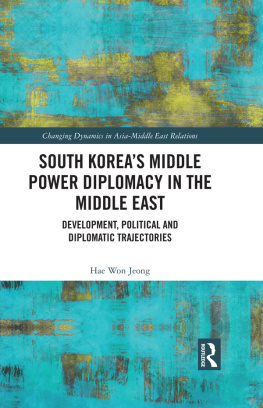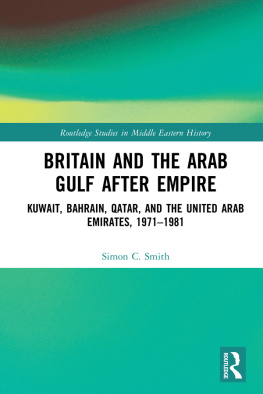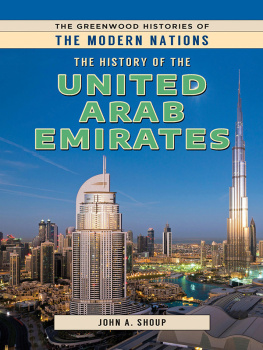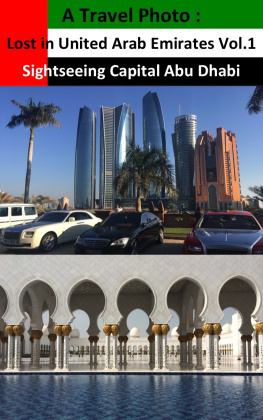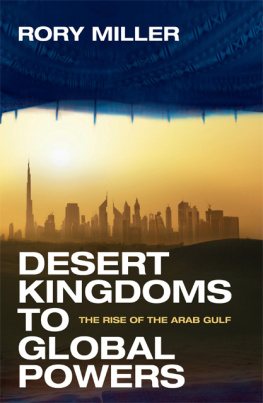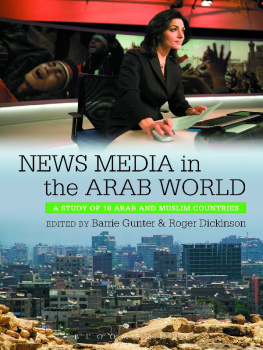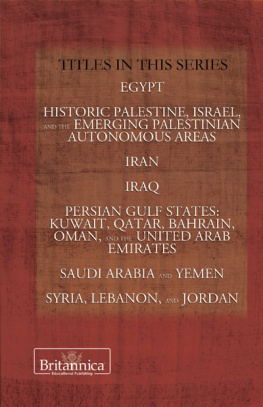ROUTLEDGE LIBRARY EDITIONS: THE ECONOMY OF THE MIDDLE EAST
Volume 13
THE ECONOMIC DEVELOPMENT OF THE UNITED ARAB EMIRATES
First published in 1981
This edition first published in 2015
by Routledge
2 Park Square, Milton Park, Abingdon, Oxon, OX14 4RN
and by Routledge
711 Third Avenue, New York, NY 10017
Routledge is an imprint of the Taylor & Francis Group, an informa business
1981 Ragaei El Mallakh
All rights reserved. No part of this book may be reprinted or reproduced or utilised in any form or by any electronic, mechanical, or other means, now known or hereafter invented, including photocopying and recording, or in any information storage or retrieval system, without permission in writing from the publishers.
Trademark notice: Product or corporate names may be trademarks or registered trademarks, and are used only for identification and explanation without intent to infringe.
British Library Cataloguing in Publication Data
A catalogue record for this book is available from the British Library
ISBN: 978-1-138-78710-0 (Set)
eISBN: 978-1-315-74408-7 (Set)
ISBN: 978-1-138-81012-9 (Volume 13)
eISBN: 978-1-315-74639-5 (Volume 13)
Publishers Note
The publisher has gone to great lengths to ensure the quality of this reprint but points out that some imperfections in the original copies may be apparent.
Disclaimer
The publisher has made every effort to trace copyright holders and would welcome correspondence from those they have been unable to trace.
1981 Ragaei El Mallakh
Croom Helm Ltd, 2 10 St Johns Road, London SW11
British Library Cataloguing in Publication Data
El Mallakh, Ragaei
The economic development of the United
Arab Emirates.
1. United Arab Emirates Economic conditions
I. Title
338.95357 HC497.U/
ISBN 0-7099-0209-3
Typeset by Leaper & Gard Ltd, Bristol
Reproduced from copy supplied
Printed and bound in Great Britain
by Billing and Sons Limited
Guildford, London, Oxford, Worcester
CONTENTS
Tables
| ADFAED | Abu Dhabi Fund for Arab Economic Development |
| ADGLC | Abu Dhabi Gas Liquefaction Company Limited |
| ADIA | Abu Dhabi Investment Authority |
| ADMA | Abu Dhabi Marine Areas, since 1978 known as ADMA-OPCO or Abu Dhabi Marine Operating Company |
| ADNOC | Abu Dhabi National Oil Company |
| ADOC | Abu Dhabi Oil Company |
| ADPC | Abu Dhabi Petroleum Company, since 1978 known as ADCO or Abu Dhabi Company for Onshore Oil Operations |
| AFESD | Arab Fund for Economic and Social Development |
| b/d | barrels per day |
| BP | British Petroleum |
| cfd | cubic feet per day |
| CFP | Compagnie Franqaise des Ptroles |
| Dh | Dirham; 1 Dirham is composed of 100 Fils; par value of 1 Dh (end of November 1978) was 0.186621 g of fine gold, equivalent to the International Monetary Funds SDR (Special Drawing Right) or 0.200797. The mid-exchange rates of Dh to 1 US $ during 1978 were: to 27 January, Dh 3.893 = $1; to 14 September, Dh 3.858 = $1; to 26 October, Dh 3.838 = $1. The 1979 and 1980 mid-rate exchange rates of dirham to dollars were: March 1979, Dh 3.838 = $1; December 1979, Dh 3.766 = $1; January 1980, Dh 4.92544 = $1; March 1980, Dh 4.6913 = $1. Another method of comparison is the dirham against the SDR in 19780: January 1978, Dh 4.71224 = 1 SDR; April 1978, Dh 4.75478 = SDR; July 1978, Dh 4.88574 = 1 SDR; October 1978, Dh 5.17666 = 1 SDR; December 1978, Dh 5.00011 = 1 SDR; March 1979, Dh 4.9388 = 1 SDR; December 1979, Dh 4.96106 = 1 SDR; January 1980, Dh 4.92544 = 1 SDR; March 1980, Dh 4.6913 = 1 SDR. |
| DPC | Dubai Petroleum Company |
| IMF | International Monetary Fund |
| JODCO | Japan Oil Development Company |
| LNG | liquefied natural gas |
| LPG | liquefied petroleum gas |
| NGL | natural gas liquids |
| PDTC | Petroleum Development (Trucial States) Ltd |
| UDECO | Umm Al-Dalkh Development Company, jointly owned by ADNOC and JODCO |
To my sisters and brothers, sisters-in-law and brother-in-law, who have given me such encouragement, support, and affection over so many years: Albert and Faiza, Betty, Nellie, Yousef and Jo, Fayek and Hilda, Naima, and Kamal.
This volume is the result of almost two decades of first-hand observation and research on the area now comprising the United Arab Emirates. In a span of less than 20 years, these sheikhdoms have undergone astonishing change, accompanied by myriad pressures, in the transformation from among the worlds poorest to among the worlds richest nations.
The reasons for this study are many. Although the United Arab Emirates (UAE) has a population of around 1 million, its oil reserves are greater than those of the United States. Given its high economic growth rate, the United Arab Emirates is an excellent laboratory in which to test and evaluate policies and programmes to effect rapid economic development. Moreover, there have been no recent economic studies on the UAE aside from that published several years ago by Dr Mana Saeed al-Otaibi, a leading economist and Minister of Petroleum and Mineral Resources of the UAE. This book seeks to trace the process of economic integration as fostered by the political federation of the seven Trucial coast emirates in 1971.
The international stature of the United Arab Emirates is far greater than its physical size, population, and breadth of resources would seem to indicate. As a member of the Organization of the Petroleum Exporting Countries (OPEC), the UAE has played a vital role within the moderate oil-pricing bloc of that body. Its petroleum policy is concerned with not only moderation in price increases but with the stability resulting from smooth, spaced and planned price hikes. Following the outbreak of hostilities between Iran and Iraq in 1980, the UAE raised its crudeoil production to help avert panic over possible supply shortfalls. Moreover, along with crude oil, the federation can boast of vast potential in natural gas.
Preparing a study on the economy of the United Arab Emirates suffers from certain difficulties and obstacles. First, because the federation is relatively young and still evolving, statistical data are often dispersed among the individual emirates rather than fully centralized in a federal statistics bureau. Abu Dhabi and Dubai have the most established documentation departments. The UAE Currency Board, replaced in December 1980 by the Central Bank, led the way in attempting to gather federation-wide economic data. The expanded power of the Central Bank in holding a specified level of revenues from the oil-producing emirates (Abu Dhabi and Dubai) should further solidify and strengthen the statistical and research arms of that institution. It should be noted that Sharjah and Ras Al-Khaimah are now upgrading their statistical collection capabilities.
Secondly, while the UAE does have a federal budget, ministries, and projects, there is a high degree of emirate autonomy in administration; this administrative unevenness is compounded by the varying degrees of development achieved by each of the seven Emirates. Abu Dhabi, Dubai, Sharjah, and Ras Al-Khaimah are more economically advanced than the three remaining emirates of Ajman, Fujairah, and Umm Al-Quwain. The differing levels of development reflect, in addition to the presence or absence of oil-generated revenues, historical biases in economic activity. For example, both Abu Dhabi and Ras Al-Khaimah have long had modest yet viable agricultural bases; Dubais major economic activity has been in its bustling trade sector with ties well beyond the nearby Gulf states.


